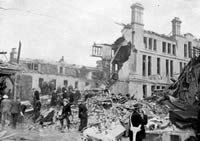Lesson Five: Promoting and Defending Against Ideologies
4. Lesson 4.5.3 Cold War - Ideologies in Conflict

British rescue workers searching through wreckage after bombing
Cold War Introduction
The defeat of Nazi Germany and the end of the World War II had a dramatic effect on the power of most European nations. European countries at the centre of the conflict were crippled physically, militarily, and economically. Although the USSR had lost about 20 million people during the war, it still remained relatively strong, second only to the United States. It was strong enough that history has defined the United States of America and the Union of Soviet Socialist Republics as the only two world superpowers following World War II. The development of nuclear weaponry and the growth of national armies continued to add superpower status to both the United States and the Soviet Union.
The end of World War II introduced a new regime on the world scene. Communism threatened liberal democratic and capitalist ideologies. Allies that had fought side by side during the war became enemies in a new kind of war, a war that was based on ideological differences between communism and capitalism.
During World War II, the USSR and the United States formed an alliance of necessity and joined to defeat fascism. However, when the common enemy had been defeated, old opinions about communism and capitalism resurfaced.

Here is a crash course on the Cold War
For more information on the Cold War: Ideologies in Conflict you can read chapter 8 of Understandings of Ideologies, pages 185-215.